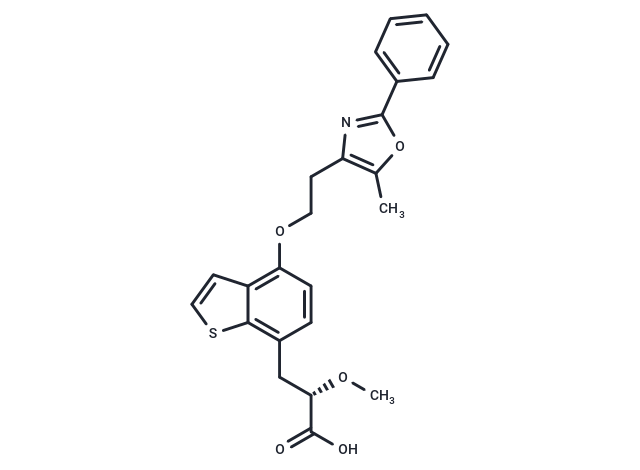Shopping Cart
Remove All Your shopping cart is currently empty
Your shopping cart is currently empty
Aleglitazar (R1439) (R1439) is a potent dual PPARα/γ agonist, with IC50s of 38 nM and 19 nM for human PPARa and PPARγ, respectively. Aleglitazar can be used for the research of type II diabetes.

| Pack Size | Price | USA Warehouse | Global Warehouse | Quantity |
|---|---|---|---|---|
| 1 mg | $258 | In Stock | In Stock | |
| 5 mg | $592 | In Stock | In Stock | |
| 10 mg | $798 | In Stock | In Stock | |
| 25 mg | $1,220 | In Stock | In Stock | |
| 50 mg | $1,650 | In Stock | In Stock | |
| 100 mg | $2,220 | - | In Stock | |
| 1 mL x 10 mM (in DMSO) | $598 | In Stock | In Stock |
| Description | Aleglitazar (R1439) (R1439) is a potent dual PPARα/γ agonist, with IC50s of 38 nM and 19 nM for human PPARa and PPARγ, respectively. Aleglitazar can be used for the research of type II diabetes. |
| Targets&IC50 | PPARγ:19 nM, PPARα:38 nM |
| In vitro | Aleglitazar exhibits species selectivity for PPARα, with EC50 values of 50 nM, 2.26 μM, and 2.34 μM for human, rat, and mouse PPARα, respectively[1]. At concentrations of 0.01-40 μM (12-48 hours), aleglitazar does not significantly increase lactate dehydrogenase (LDH) release at 0.1-20 μM but shows significant increases at 30 μM and 40 μM[2]. Additionally, aleglitazar (0.01-20 μM; 48 hours) decreases hyperglycemia (HG, glucose 25 mM)-induced apoptosis, caspase-3 activity, and cytochrome-C release, while improving cell viability in hyperglycemic conditions[2]. |
| In vivo | Aleglitazar (0.3-3.0 mg/kg; i.p.; daily; for 7 days) exerts beneficial effects on structural and functional outcomes of mild brain ischemia, reduces key aspects of microglia activation including NO production, release of proinflammatory cytokines, migration, and phagocytosis, and attenuates inflammatory responses in the post-ischemic brain[3]. |
| Synonyms | RO0728804, R1439 |
| Molecular Weight | 437.51 |
| Formula | C24H23NO5S |
| Cas No. | 475479-34-6 |
| Smiles | C([C@@H](C(O)=O)OC)C1=C2C(=C(OCCC=3N=C(OC3C)C4=CC=CC=C4)C=C1)C=CS2 |
| Relative Density. | 1.29 |
| Color | White |
| Appearance | Solid |
| Storage | Powder: -20°C for 3 years | In solvent: -80°C for 1 year | Shipping with blue ice/Shipping at ambient temperature. | |||||||||||||||||||||||||||||||||||
| Solubility Information | DMSO: 45 mg/mL (102.85 mM), Sonication is recommended. | |||||||||||||||||||||||||||||||||||
| In Vivo Formulation | 10% DMSO+40% PEG300+5% Tween 80+45% Saline: 2 mg/mL (4.57 mM), Sonication is recommended. Please add the solvents sequentially, clarifying the solution as much as possible before adding the next one. Dissolve by heating and/or sonication if necessary. Working solution is recommended to be prepared and used immediately. The formulation provided above is for reference purposes only. In vivo formulations may vary and should be modified based on specific experimental conditions. | |||||||||||||||||||||||||||||||||||
Solution Preparation Table | ||||||||||||||||||||||||||||||||||||
DMSO
| ||||||||||||||||||||||||||||||||||||
| Size | Quantity | Unit Price | Amount | Operation |
|---|

Copyright © 2015-2025 TargetMol Chemicals Inc. All Rights Reserved.